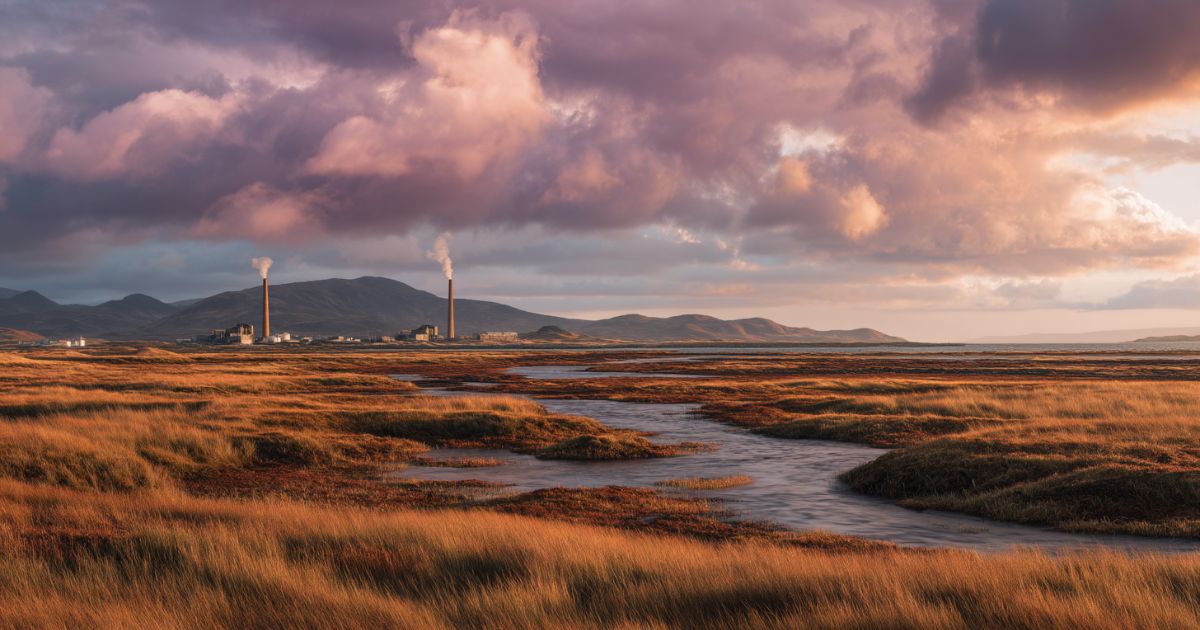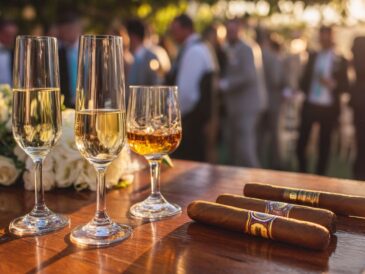🗝️ Quick Answer
Islay Scotch whisky is renowned for its smoky, maritime flavor, created by burning peat—decomposed moss and seaweed from the island’s bogs—to dry malted barley. Each Islay distillery uses peat, water, and aging differently, producing whiskies that range from Laphroaig’s medicinal smoke to Bowmore’s gentle fruit-and-sherry sweetness.
The Island That Shaped a Flavor
Off Scotland’s southwest coast lies Islay, a rugged island of heather, rain, and bog. With limited trees for firewood, early residents turned to peat as a vital fuel source. Peat forms over thousands of years as layers of moss and heather decay under water, compacting into dense, smoky turf.
When distillers began drying malted barley over peat fires, the smoke drifted through the grain, bonding chemically with it. Those compounds—known as phenols—became the backbone of Islay’s unmistakable flavor: earthy, briny, and rich in campfire aroma. What started as a necessity became an identity that still defines Islay Scotch whisky.

A Short History of Islay Scotch Whisky
Distilling on Islay predates official records. By the 18th century, farmers were already running small, hidden stills in the glens to avoid excise taxes. The Excise Act of 1823 finally legalized distillation for a modest license fee, prompting families across the island to establish commercial operations.
Islay is one of Scotland’s five protected Scotch whisky regions, each with distinct styles and histories (see the Scotch Whisky Association’s overview of Scotch whisky regions).
Names such as Laphroaig (1815), Lagavulin (1816), and Bowmore (1779) date from this period. As shipping improved, Islay whisky reached Glasgow and London, gaining a reputation for strength and smoky depth. By the late 19th century, Islay had more than a dozen legal distilleries, many of which still anchor the island’s economy and global reputation today.
The Science of Smoke
Peat imparts character during the malting stage, when wet barley is dried over smouldering fires. The intensity of smokiness is measured in parts per million (PPM) of phenols:
-
Lightly peated: 10–20 PPM – subtle campfire and salt air.
-
Medium peated: 20–35 PPM – classic balanced Islay character.
-
Heavily peated: 40–60 PPM – medicinal, tarry, full-bodied smoke.
Even the island’s water contributes. Streams flow through peat bogs, tinting them brown and enriching the wash with earthy compounds before it reaches the stills. Combined with copper still shapes, long fermentation, and maritime aging, these elements give Islay whiskies their distinctive balance of smoke, salt, and sweetness.
How Peat Is Harvested and Used
Peat cutting remains part of island life. Each spring, workers slice rectangular blocks from the bogs using traditional spades called tairsgeirs. The blocks are stacked and left to dry in the wind for several months. The top layer of peat burns quickly, producing clean smoke; the deeper layers are denser, generating heavier aromas and long-lasting embers.
Distilleries such as Laphroaig and Kilchoman still source peat from nearby bogs, while others rely on the Port Ellen Maltings facility. Different bog locations create subtle variations—some richer in seaweed and salt, others grassy and floral. These nuances are what give each whisky its signature character.
The Five Distilleries That Define Islay

Laphroaig Distillery (Founded 1815)
Located near Port Ellen, Laphroaig maintains traditional floor maltings for part of its production and burns peat from the island’s south coast. The result is a whisky noted for iodine, seaweed, and smoky intensity. Matured mainly in ex-bourbon barrels, the 10-Year-Old remains a global benchmark—complex, medicinal, and uncompromising. Visitors can tour the malting floors, taste cask-strength editions, and even adopt a square foot of the distillery’s peat field through its “Friends of Laphroaig” program.
Lagavulin Distillery (Founded 1816)
Neighbouring Laphroaig along the same shoreline, Lagavulin produces a heavier, slower spirit through long fermentation and gradual distillation. The Lagavulin 16-Year-Old, part of Diageo’s Classic Malts range, balances deep peat with sherry sweetness and dried fruit. The distillery offers one of Islay’s most scenic tasting experiences, overlooking Lagavulin Bay and the ruins of Dunyvaig Castle.
Ardbeg Distillery (Founded 1815)
Once closed during the 1980s downturn, Ardbeg was revived in 1997 by Glenmorangie PLC and quickly became a cult favourite. With peat levels around 55 PPM, its whiskies rank among Scotland’s smokiest. A unique purifier system on the stills refines the spirit, yielding layers of citrus, espresso, and tar. Popular bottlings such as Ardbeg 10, Uigeadail, and Corryvreckan showcase its modern blend of innovation and tradition.
Bowmore Distillery (Founded 1779)
The island’s oldest licensed distillery, Bowmore, still hand-malts about 30% of its barley and matures spirit in the legendary No. 1 Vaults, a warehouse below sea level. Its medium-peated profile bridges the gap between gentle Highland malts and intense Islay smoke. Core expressions like Bowmore 12 and 15-Year Sherry Cask reveal tropical fruit, toffee, and balanced peat—making Bowmore the ideal gateway for newcomers.
Kilchoman Distillery (Founded 2005)
Breaking a century-long gap in Islay whisky history, Kilchoman became the island’s first new distillery in generations. It operates as a farm-to-bottle producer, growing, malting, distilling, and bottling on-site. Its Machir Bay and Sanaig releases combine fresh citrus and clean smoke, reflecting youthful vibrancy grounded in old methods. Visitors can walk the barley fields, tour the small stillhouse, and see traditional peat drying firsthand.
Experiencing Islay
For whisky lovers, visiting Islay is a pilgrimage. The island hosts the annual Fèis Ìle festival each May, where every distillery opens its doors for special tastings, music, and community events. Travel between distilleries is easy—most lie within a short drive or coastal walk of one another.
Tasting flights often begin with Bowmore or Bunnahabhain (lighter peat) before progressing to the south-coast giants like Laphroaig and Ardbeg. Each dram offers a different perspective on the same elemental ingredients: peat, water, and sea air. For many, that diversity is the true magic of Islay.
Bo’s Barrel Notes
Pour a glass of Lagavulin 16 or Laphroaig 10 and take a slow breath. The aroma rises with campfire smoke, salt, and lemon peel. On the palate, the peat warmth meets malt sweetness and oak spice before fading into a long, ashy finish.
Islay whisky is not polite—it’s honest. Each sip feels like a handshake from the island itself: rough, warm, and unforgettable.
The Pairing Room: Cigars & Food
Laphroaig 10
-
Cigars: Perdomo 10th Anniversary Maduro, Oliva Serie V Melanio Maduro – chocolate and espresso temper the peat.
-
Food: Blue cheese with honey or smoked almonds accentuates sweetness and salt.
Lagavulin 16
-
Cigars: My Father Le Bijou 1922, Arturo Fuente Don Carlos – spice and cedar harmonize with deep smoke.
-
Food: Grilled lamb chops or charred steak mirror Lagavulin’s savoury richness.
Ardbeg 10 / Uigeadail
-
Cigars: Padron 1964 Anniversary Maduro, La Flor Dominicana Double Ligero – bold enough to match 50+ PPM peat.
-
Food: Dark chocolate with sea salt or smoked brisket elevates its intensity.
Pro Tip: A strong espresso or cold brew reveals hidden sweetness and softens the peat’s edge.
The Spirit and Pride of Islay
What makes Islay unique is its sense of place. Every distillery shares the same small island, yet each expresses it differently—Laphroaig’s medicinal fire, Lagavulin’s patient depth, Ardbeg’s engineered chaos, Bowmore’s elegant balance, Kilchoman’s youthful purity.
These whiskies have won countless international awards and inspired one of the world’s most loyal fan bases. They embody the idea that even the hardest ground can yield the richest soul.
Frequently Asked Questions About Islay Scotch Whisky
Why is Islay Scotch whisky so smoky?
Distillers dry malted barley over peat fires. The smoke’s phenols bind to the grain, creating the island’s distinctive smoky flavor.
Which Islay distilleries are the smokiest?
Ardbeg, Laphroaig, and Lagavulin use the heaviest peating levels—often exceeding 40 PPM—for the boldest smoke and iodine notes.
What cigars pair best with Islay Scotch Whisky?
Full-bodied cigars with cocoa, spice, or coffee undertones—like Padron 1964 Maduro or My Father Le Bijou—balance intense peat beautifully.
What foods complement smoky whisky?
Charred meats, aged cheeses, and dark chocolate pair naturally with peated Scotch, highlighting both sweetness and smoke.
Listen to the full story: Cigar & Whiskey Podcast

Bo Kauffmann is the voice behind Cigar and Whiskey Guide and Smoke Signals on Substack, where he shares expert reviews, pairings, and lifestyle insights for enthusiasts around the world. A longtime cigar lover and bourbon explorer, Bo blends storytelling with deep knowledge to help readers savor every pour and every puff.








